Strategic Inclusion and Diversity Management Report for Marriott Hotel
VerifiedAdded on 2020/06/05
|13
|3685
|44
Report
AI Summary
This report provides an analysis of diversity and inclusion challenges within Marriott Hotel, focusing on issues related to ethnic and cultural differences among employees. It explores the impact of these differences on employee relations, target audience engagement, and communication barriers. The report identifies key findings and recommends strategic inclusion and diversity directions, including fairness, encouraging leaders to provide equal respect, and fostering an open environment. Task 2 outlines a project aimed at empowering individuals from diverse backgrounds within Marriott Hotel in Australia. The project's desired outcomes are to reduce prejudice and discrimination, adopt diversity as a competitive advantage, and ensure equal treatment for all employees. The report details strategies such as policy inclusion and restructuring organizational development activities, along with implementation steps, responsible parties, required resources, and evaluation mechanisms. The report aims to provide Marriott Hotel with practical strategies to promote a more inclusive and diverse workplace.
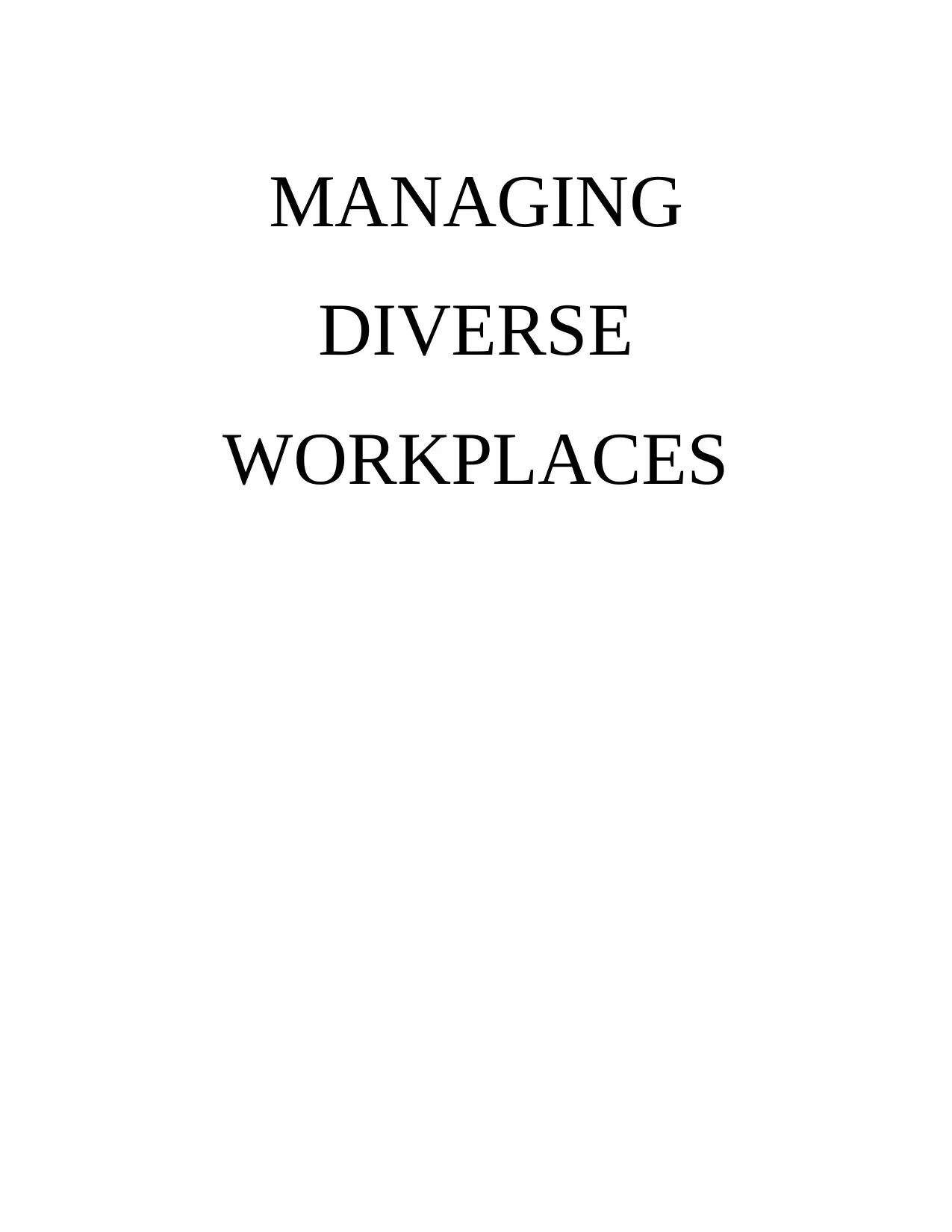
MANAGING
DIVERSE
WORKPLACES
DIVERSE
WORKPLACES
Paraphrase This Document
Need a fresh take? Get an instant paraphrase of this document with our AI Paraphraser
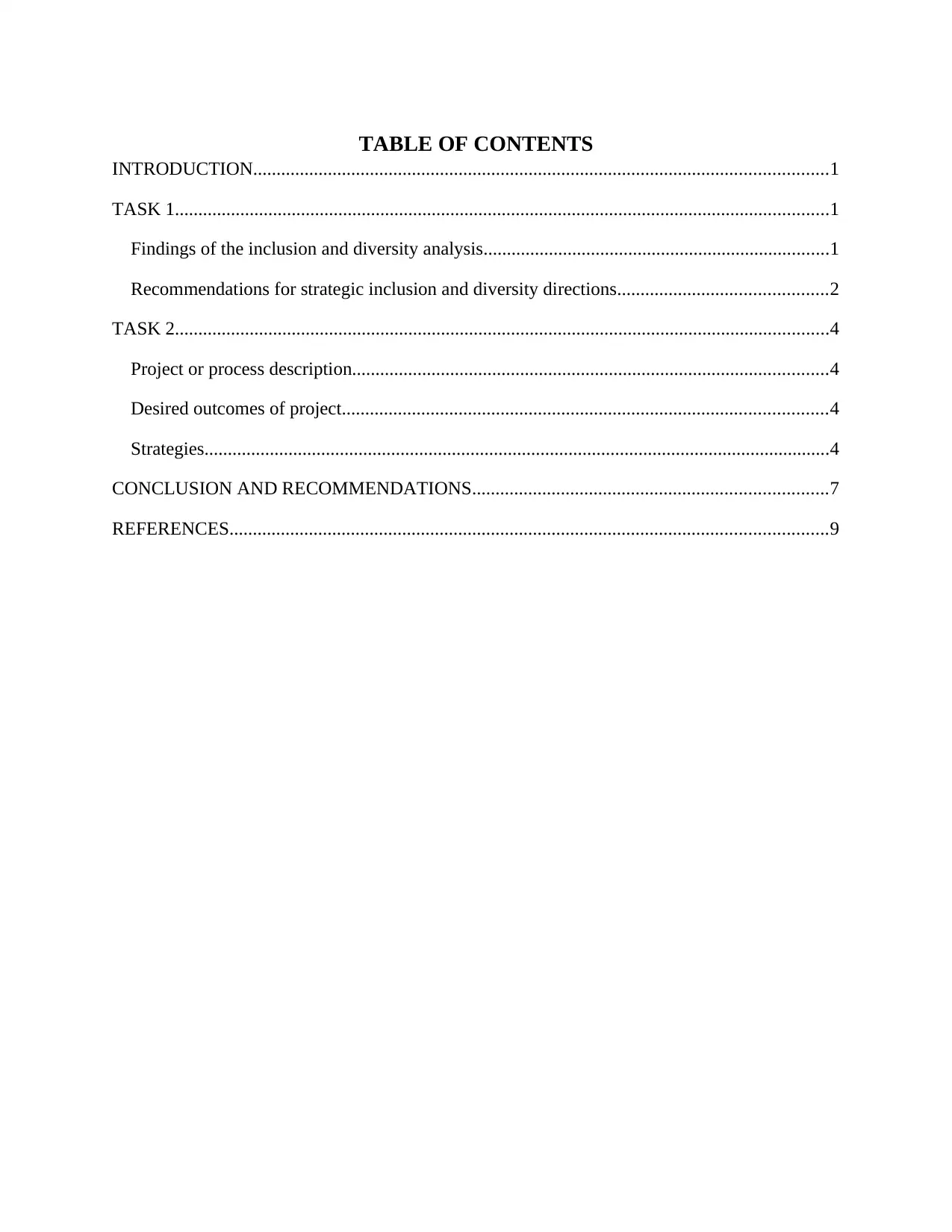
TABLE OF CONTENTS
INTRODUCTION...........................................................................................................................1
TASK 1............................................................................................................................................1
Findings of the inclusion and diversity analysis..........................................................................1
Recommendations for strategic inclusion and diversity directions.............................................2
TASK 2............................................................................................................................................4
Project or process description......................................................................................................4
Desired outcomes of project........................................................................................................4
Strategies......................................................................................................................................4
CONCLUSION AND RECOMMENDATIONS............................................................................7
REFERENCES................................................................................................................................9
INTRODUCTION...........................................................................................................................1
TASK 1............................................................................................................................................1
Findings of the inclusion and diversity analysis..........................................................................1
Recommendations for strategic inclusion and diversity directions.............................................2
TASK 2............................................................................................................................................4
Project or process description......................................................................................................4
Desired outcomes of project........................................................................................................4
Strategies......................................................................................................................................4
CONCLUSION AND RECOMMENDATIONS............................................................................7
REFERENCES................................................................................................................................9
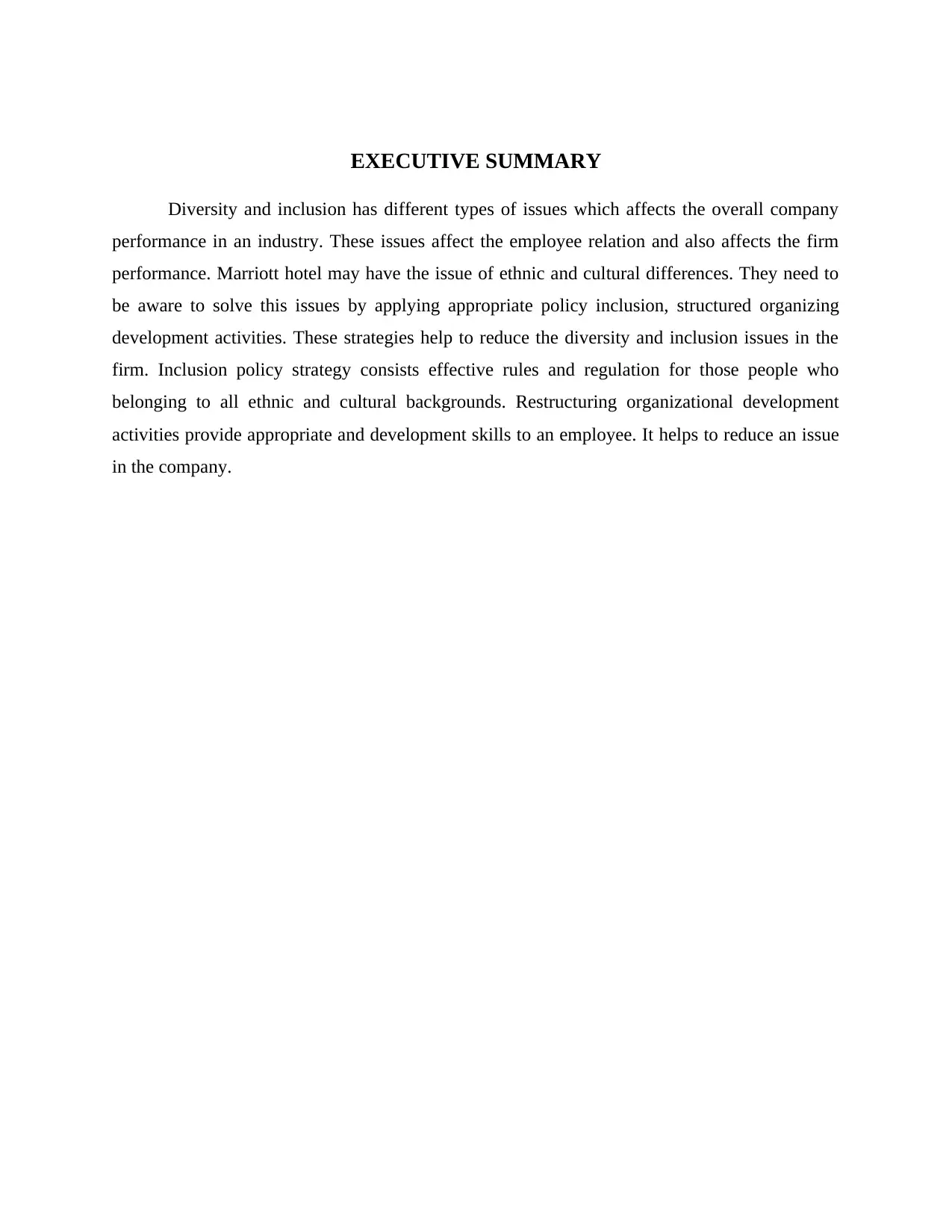
EXECUTIVE SUMMARY
Diversity and inclusion has different types of issues which affects the overall company
performance in an industry. These issues affect the employee relation and also affects the firm
performance. Marriott hotel may have the issue of ethnic and cultural differences. They need to
be aware to solve this issues by applying appropriate policy inclusion, structured organizing
development activities. These strategies help to reduce the diversity and inclusion issues in the
firm. Inclusion policy strategy consists effective rules and regulation for those people who
belonging to all ethnic and cultural backgrounds. Restructuring organizational development
activities provide appropriate and development skills to an employee. It helps to reduce an issue
in the company.
Diversity and inclusion has different types of issues which affects the overall company
performance in an industry. These issues affect the employee relation and also affects the firm
performance. Marriott hotel may have the issue of ethnic and cultural differences. They need to
be aware to solve this issues by applying appropriate policy inclusion, structured organizing
development activities. These strategies help to reduce the diversity and inclusion issues in the
firm. Inclusion policy strategy consists effective rules and regulation for those people who
belonging to all ethnic and cultural backgrounds. Restructuring organizational development
activities provide appropriate and development skills to an employee. It helps to reduce an issue
in the company.
⊘ This is a preview!⊘
Do you want full access?
Subscribe today to unlock all pages.

Trusted by 1+ million students worldwide
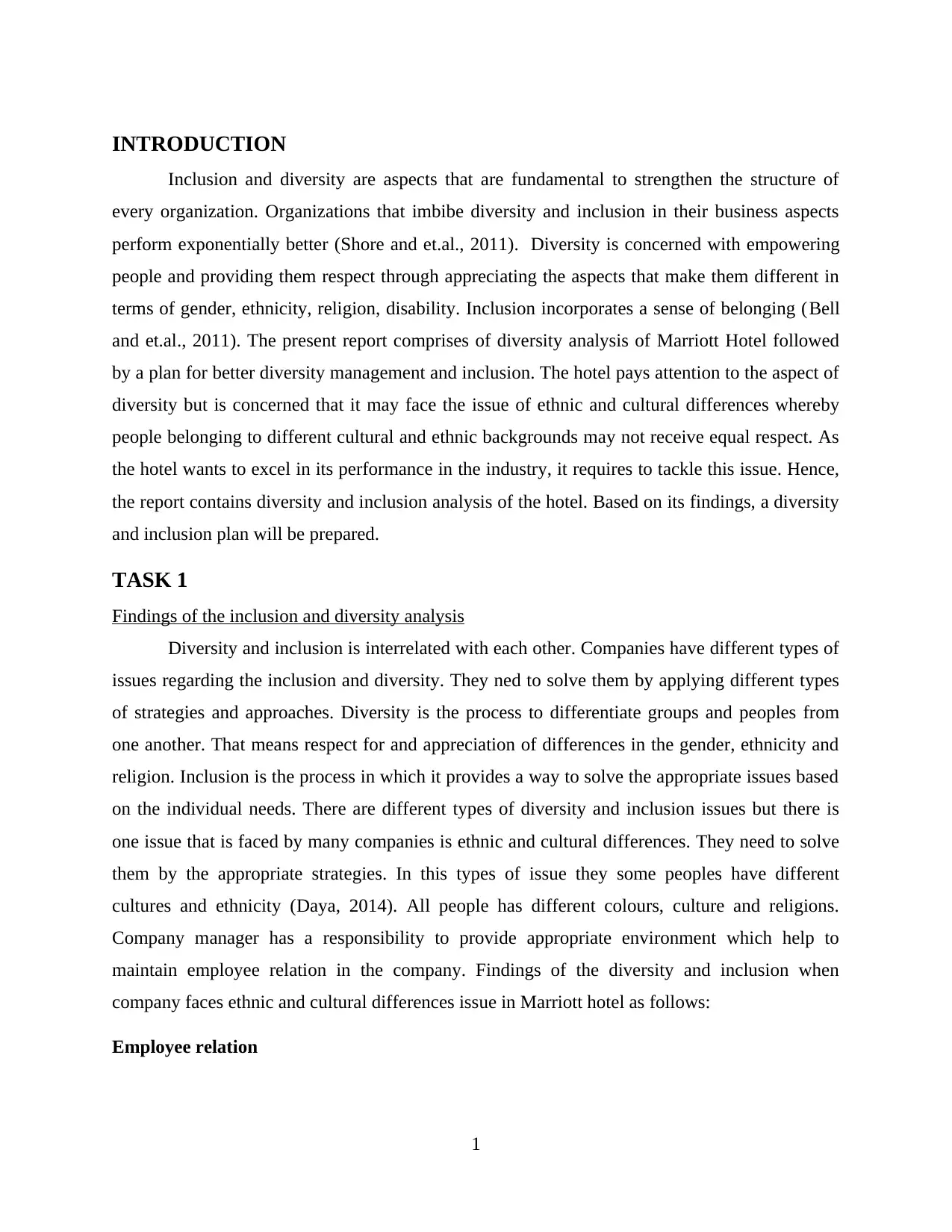
INTRODUCTION
Inclusion and diversity are aspects that are fundamental to strengthen the structure of
every organization. Organizations that imbibe diversity and inclusion in their business aspects
perform exponentially better (Shore and et.al., 2011). Diversity is concerned with empowering
people and providing them respect through appreciating the aspects that make them different in
terms of gender, ethnicity, religion, disability. Inclusion incorporates a sense of belonging (Bell
and et.al., 2011). The present report comprises of diversity analysis of Marriott Hotel followed
by a plan for better diversity management and inclusion. The hotel pays attention to the aspect of
diversity but is concerned that it may face the issue of ethnic and cultural differences whereby
people belonging to different cultural and ethnic backgrounds may not receive equal respect. As
the hotel wants to excel in its performance in the industry, it requires to tackle this issue. Hence,
the report contains diversity and inclusion analysis of the hotel. Based on its findings, a diversity
and inclusion plan will be prepared.
TASK 1
Findings of the inclusion and diversity analysis
Diversity and inclusion is interrelated with each other. Companies have different types of
issues regarding the inclusion and diversity. They ned to solve them by applying different types
of strategies and approaches. Diversity is the process to differentiate groups and peoples from
one another. That means respect for and appreciation of differences in the gender, ethnicity and
religion. Inclusion is the process in which it provides a way to solve the appropriate issues based
on the individual needs. There are different types of diversity and inclusion issues but there is
one issue that is faced by many companies is ethnic and cultural differences. They need to solve
them by the appropriate strategies. In this types of issue they some peoples have different
cultures and ethnicity (Daya, 2014). All people has different colours, culture and religions.
Company manager has a responsibility to provide appropriate environment which help to
maintain employee relation in the company. Findings of the diversity and inclusion when
company faces ethnic and cultural differences issue in Marriott hotel as follows:
Employee relation
1
Inclusion and diversity are aspects that are fundamental to strengthen the structure of
every organization. Organizations that imbibe diversity and inclusion in their business aspects
perform exponentially better (Shore and et.al., 2011). Diversity is concerned with empowering
people and providing them respect through appreciating the aspects that make them different in
terms of gender, ethnicity, religion, disability. Inclusion incorporates a sense of belonging (Bell
and et.al., 2011). The present report comprises of diversity analysis of Marriott Hotel followed
by a plan for better diversity management and inclusion. The hotel pays attention to the aspect of
diversity but is concerned that it may face the issue of ethnic and cultural differences whereby
people belonging to different cultural and ethnic backgrounds may not receive equal respect. As
the hotel wants to excel in its performance in the industry, it requires to tackle this issue. Hence,
the report contains diversity and inclusion analysis of the hotel. Based on its findings, a diversity
and inclusion plan will be prepared.
TASK 1
Findings of the inclusion and diversity analysis
Diversity and inclusion is interrelated with each other. Companies have different types of
issues regarding the inclusion and diversity. They ned to solve them by applying different types
of strategies and approaches. Diversity is the process to differentiate groups and peoples from
one another. That means respect for and appreciation of differences in the gender, ethnicity and
religion. Inclusion is the process in which it provides a way to solve the appropriate issues based
on the individual needs. There are different types of diversity and inclusion issues but there is
one issue that is faced by many companies is ethnic and cultural differences. They need to solve
them by the appropriate strategies. In this types of issue they some peoples have different
cultures and ethnicity (Daya, 2014). All people has different colours, culture and religions.
Company manager has a responsibility to provide appropriate environment which help to
maintain employee relation in the company. Findings of the diversity and inclusion when
company faces ethnic and cultural differences issue in Marriott hotel as follows:
Employee relation
1
Paraphrase This Document
Need a fresh take? Get an instant paraphrase of this document with our AI Paraphraser

To reduce the complexity of diversity and inclusion issue they need to maintain employee
relation in the firm. Ethnic and cultural issue affect the employee relation in an entity. All
employees have different backgrounds and cultures so they are not able to communicate with
each other. All have different opinion and thoughts to do their work or to solve appropriate
problem in an entity. This factors of this issue affects the employee relation in the hotel (Derven,
2014).
Target audience
Ethnic and cultural differences affects the overall company performance. All employee
has different cultural and backgrounds so they are not able to communicate with each other.
When launch the marketing advertisement to a member of a different culture, always research
the target market prior to the beginning the campaign. Presenting the advertisement that is not in
the line with the specific culture norms can easily insult the target audience and greatly prevent
the advertisement.
Language barriers
All employees have different cultural and backgrounds. They also prefer different
languages to communicate with each other. In some countries like UK it is common for some
people to speak loudly and to be more aggressive. So there are different types of interaction
forms in the employees. For the effective business communication manager has a responsibility
provide appropriate environment to an employees so that they cane easily interact with each
other in an entity.
These all the key findings that affects their overall company performance. To maintain
the firm environment they need to plan to solve particular issues. Marriott hotel manager has a
responsibility to manage this issue by providing appropriate solutions to an employee. This issue
directly affects the entity performance in the industry (Cultural differences in the workplace,
2016).
Recommendations for strategic inclusion and diversity directions
To manage the diversity in the hotel they need to follow different strategies and
approaches which help to reduce the complexity of an issue. In Marriott hotel there is an issue
such as ethnic and cultural issue in which all employees have different backgrounds, ethnics and
2
relation in the firm. Ethnic and cultural issue affect the employee relation in an entity. All
employees have different backgrounds and cultures so they are not able to communicate with
each other. All have different opinion and thoughts to do their work or to solve appropriate
problem in an entity. This factors of this issue affects the employee relation in the hotel (Derven,
2014).
Target audience
Ethnic and cultural differences affects the overall company performance. All employee
has different cultural and backgrounds so they are not able to communicate with each other.
When launch the marketing advertisement to a member of a different culture, always research
the target market prior to the beginning the campaign. Presenting the advertisement that is not in
the line with the specific culture norms can easily insult the target audience and greatly prevent
the advertisement.
Language barriers
All employees have different cultural and backgrounds. They also prefer different
languages to communicate with each other. In some countries like UK it is common for some
people to speak loudly and to be more aggressive. So there are different types of interaction
forms in the employees. For the effective business communication manager has a responsibility
provide appropriate environment to an employees so that they cane easily interact with each
other in an entity.
These all the key findings that affects their overall company performance. To maintain
the firm environment they need to plan to solve particular issues. Marriott hotel manager has a
responsibility to manage this issue by providing appropriate solutions to an employee. This issue
directly affects the entity performance in the industry (Cultural differences in the workplace,
2016).
Recommendations for strategic inclusion and diversity directions
To manage the diversity in the hotel they need to follow different strategies and
approaches which help to reduce the complexity of an issue. In Marriott hotel there is an issue
such as ethnic and cultural issue in which all employees have different backgrounds, ethnics and
2
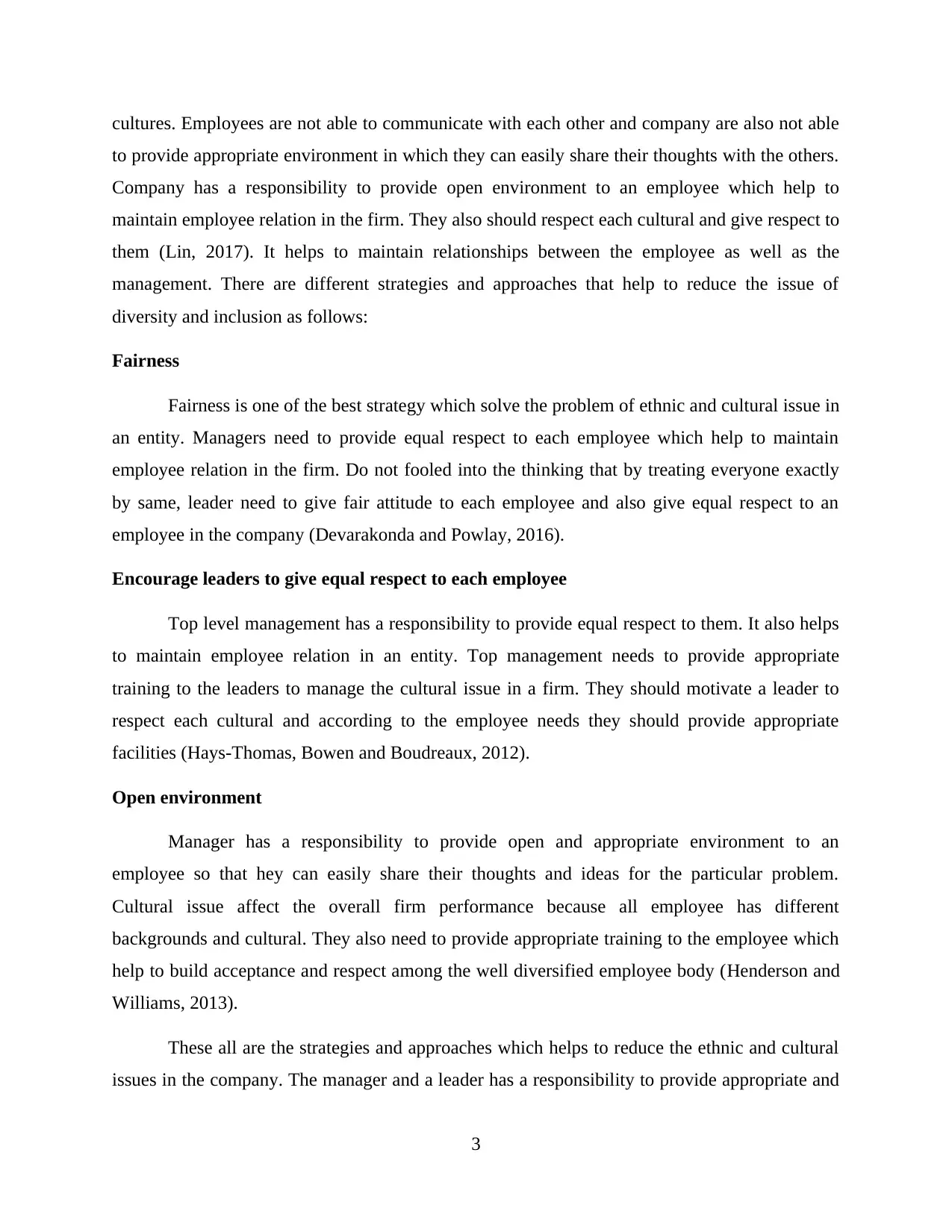
cultures. Employees are not able to communicate with each other and company are also not able
to provide appropriate environment in which they can easily share their thoughts with the others.
Company has a responsibility to provide open environment to an employee which help to
maintain employee relation in the firm. They also should respect each cultural and give respect to
them (Lin, 2017). It helps to maintain relationships between the employee as well as the
management. There are different strategies and approaches that help to reduce the issue of
diversity and inclusion as follows:
Fairness
Fairness is one of the best strategy which solve the problem of ethnic and cultural issue in
an entity. Managers need to provide equal respect to each employee which help to maintain
employee relation in the firm. Do not fooled into the thinking that by treating everyone exactly
by same, leader need to give fair attitude to each employee and also give equal respect to an
employee in the company (Devarakonda and Powlay, 2016).
Encourage leaders to give equal respect to each employee
Top level management has a responsibility to provide equal respect to them. It also helps
to maintain employee relation in an entity. Top management needs to provide appropriate
training to the leaders to manage the cultural issue in a firm. They should motivate a leader to
respect each cultural and according to the employee needs they should provide appropriate
facilities (Hays-Thomas, Bowen and Boudreaux, 2012).
Open environment
Manager has a responsibility to provide open and appropriate environment to an
employee so that hey can easily share their thoughts and ideas for the particular problem.
Cultural issue affect the overall firm performance because all employee has different
backgrounds and cultural. They also need to provide appropriate training to the employee which
help to build acceptance and respect among the well diversified employee body (Henderson and
Williams, 2013).
These all are the strategies and approaches which helps to reduce the ethnic and cultural
issues in the company. The manager and a leader has a responsibility to provide appropriate and
3
to provide appropriate environment in which they can easily share their thoughts with the others.
Company has a responsibility to provide open environment to an employee which help to
maintain employee relation in the firm. They also should respect each cultural and give respect to
them (Lin, 2017). It helps to maintain relationships between the employee as well as the
management. There are different strategies and approaches that help to reduce the issue of
diversity and inclusion as follows:
Fairness
Fairness is one of the best strategy which solve the problem of ethnic and cultural issue in
an entity. Managers need to provide equal respect to each employee which help to maintain
employee relation in the firm. Do not fooled into the thinking that by treating everyone exactly
by same, leader need to give fair attitude to each employee and also give equal respect to an
employee in the company (Devarakonda and Powlay, 2016).
Encourage leaders to give equal respect to each employee
Top level management has a responsibility to provide equal respect to them. It also helps
to maintain employee relation in an entity. Top management needs to provide appropriate
training to the leaders to manage the cultural issue in a firm. They should motivate a leader to
respect each cultural and according to the employee needs they should provide appropriate
facilities (Hays-Thomas, Bowen and Boudreaux, 2012).
Open environment
Manager has a responsibility to provide open and appropriate environment to an
employee so that hey can easily share their thoughts and ideas for the particular problem.
Cultural issue affect the overall firm performance because all employee has different
backgrounds and cultural. They also need to provide appropriate training to the employee which
help to build acceptance and respect among the well diversified employee body (Henderson and
Williams, 2013).
These all are the strategies and approaches which helps to reduce the ethnic and cultural
issues in the company. The manager and a leader has a responsibility to provide appropriate and
3
⊘ This is a preview!⊘
Do you want full access?
Subscribe today to unlock all pages.

Trusted by 1+ million students worldwide

open environment to an employee which helps to maintain employee relation in the company. It
also helps to increase overall performance in an industry (Valls and Kyriakides, 2013). Marriott
Hotel follows these approaches to solve the ethnic and cultural issue in an entity. Top level
management motivates the leaders to provide open environment and policies to an employee so
that they can easily communicate with each other (Diversity and inclusion, 2017).
TASK 2
Project or process description
This project is related to empowering the people belonging to different ethnic and
cultural backgrounds within Marriott Hotel in Australia. The people belonging to different
cultural backgrounds such as Torres and Islander communities in Australia as well as those from
other ethnicities are to be provided equal rights and development opportunities within the
organization (Barak, 2016). The project draws upon how the organization can best respect the
cultural and ethnic differences present within the workplace.
Desired outcomes of project
The project is intended to provide the following desired outcomes:
It will enable the organization to emphasize on reduction of prejudice and discrimination
thereby leading to new policies, structures and behaviors at the workplace (Besler and
Sezerel, 2012).
It will further help in going beyond the traditional drivers of change and adopting
diversity as a competitive advantage.
The project is intended to foster equal treatment to each person thereby recognizing every
individual as unique and diversely skilled.
It will make the organization competent to stay ahead of its competitors in terms of
economic results, social cohesion and environmental responsibility (GÜMÜŞ, M., 2010).
Strategies
Respecting ethnic and cultural differences would require formulation and execution of
various strategies. In order to implement the plan, the following strategies have been identified:
Policy inclusion
4
also helps to increase overall performance in an industry (Valls and Kyriakides, 2013). Marriott
Hotel follows these approaches to solve the ethnic and cultural issue in an entity. Top level
management motivates the leaders to provide open environment and policies to an employee so
that they can easily communicate with each other (Diversity and inclusion, 2017).
TASK 2
Project or process description
This project is related to empowering the people belonging to different ethnic and
cultural backgrounds within Marriott Hotel in Australia. The people belonging to different
cultural backgrounds such as Torres and Islander communities in Australia as well as those from
other ethnicities are to be provided equal rights and development opportunities within the
organization (Barak, 2016). The project draws upon how the organization can best respect the
cultural and ethnic differences present within the workplace.
Desired outcomes of project
The project is intended to provide the following desired outcomes:
It will enable the organization to emphasize on reduction of prejudice and discrimination
thereby leading to new policies, structures and behaviors at the workplace (Besler and
Sezerel, 2012).
It will further help in going beyond the traditional drivers of change and adopting
diversity as a competitive advantage.
The project is intended to foster equal treatment to each person thereby recognizing every
individual as unique and diversely skilled.
It will make the organization competent to stay ahead of its competitors in terms of
economic results, social cohesion and environmental responsibility (GÜMÜŞ, M., 2010).
Strategies
Respecting ethnic and cultural differences would require formulation and execution of
various strategies. In order to implement the plan, the following strategies have been identified:
Policy inclusion
4
Paraphrase This Document
Need a fresh take? Get an instant paraphrase of this document with our AI Paraphraser

This is the first strategy through which diversity and inclusion could be fostered at the
workplace by resolving the issue of ethnic and cultural differences. If Marriott hotel wants to
create a culture of inclusion, it needs to have a policy framework in place. The policy should not
only outline the position that organization takes on discrimination but also guidelines for conduct
and behavior should also be clearly stated (Singal, 2014).
a) Anticipated Results- The strategy of policy inclusion will provide a framework for
appropriate conduct and behavior at the workplace. It will set rules regarding
inclusion of people belonging to all ethnic and cultural background at various levels
and activities of organization (Tatli, A. and Özbilgin, 2012). It will further identify
the barriers faced by the employees due to cultural differences. This is intended to
provide adequate opportunities to the workforce members for career growth.
b) Actions- The actions to be taken for implementing the strategy would comprise of
planning a schedule for meetings that would involve workforce members at all
levels to include the necessary points during forming the policy (Özbilgin and et.al.,
2011). After the meetings have been conducted at all levels within the organization,
the views of staff at all levels will be evaluated and compiled to form a policy. The
policy will then be screening to form into a final document. This will be
communicated to the staff through emails.
c) Who is responsible- The senior management is responsible for effectively
conducting the meetings and analyzing its findings to form a concrete policy
framework. The senior managers will be responsible for effective communication
and implementation of policy.
d) Stakeholders/who is involved- during the formation of policy, the employees,
middle management as well as senior management will be involved. It will also be
headed by the COO of the organization. Experts on diversity management will also
be involved in ascertaining that the policy contains all the necessary principles
(Zanoni and et.al., 2010).
e) Resources required- The policy will require resources in the form of time and
expertise.
f) Timeframe- The formulation of policy will require a time frame of 1 to 1 and a half
month. Further, its successful implementation will require a time period of another 2
5
workplace by resolving the issue of ethnic and cultural differences. If Marriott hotel wants to
create a culture of inclusion, it needs to have a policy framework in place. The policy should not
only outline the position that organization takes on discrimination but also guidelines for conduct
and behavior should also be clearly stated (Singal, 2014).
a) Anticipated Results- The strategy of policy inclusion will provide a framework for
appropriate conduct and behavior at the workplace. It will set rules regarding
inclusion of people belonging to all ethnic and cultural background at various levels
and activities of organization (Tatli, A. and Özbilgin, 2012). It will further identify
the barriers faced by the employees due to cultural differences. This is intended to
provide adequate opportunities to the workforce members for career growth.
b) Actions- The actions to be taken for implementing the strategy would comprise of
planning a schedule for meetings that would involve workforce members at all
levels to include the necessary points during forming the policy (Özbilgin and et.al.,
2011). After the meetings have been conducted at all levels within the organization,
the views of staff at all levels will be evaluated and compiled to form a policy. The
policy will then be screening to form into a final document. This will be
communicated to the staff through emails.
c) Who is responsible- The senior management is responsible for effectively
conducting the meetings and analyzing its findings to form a concrete policy
framework. The senior managers will be responsible for effective communication
and implementation of policy.
d) Stakeholders/who is involved- during the formation of policy, the employees,
middle management as well as senior management will be involved. It will also be
headed by the COO of the organization. Experts on diversity management will also
be involved in ascertaining that the policy contains all the necessary principles
(Zanoni and et.al., 2010).
e) Resources required- The policy will require resources in the form of time and
expertise.
f) Timeframe- The formulation of policy will require a time frame of 1 to 1 and a half
month. Further, its successful implementation will require a time period of another 2
5
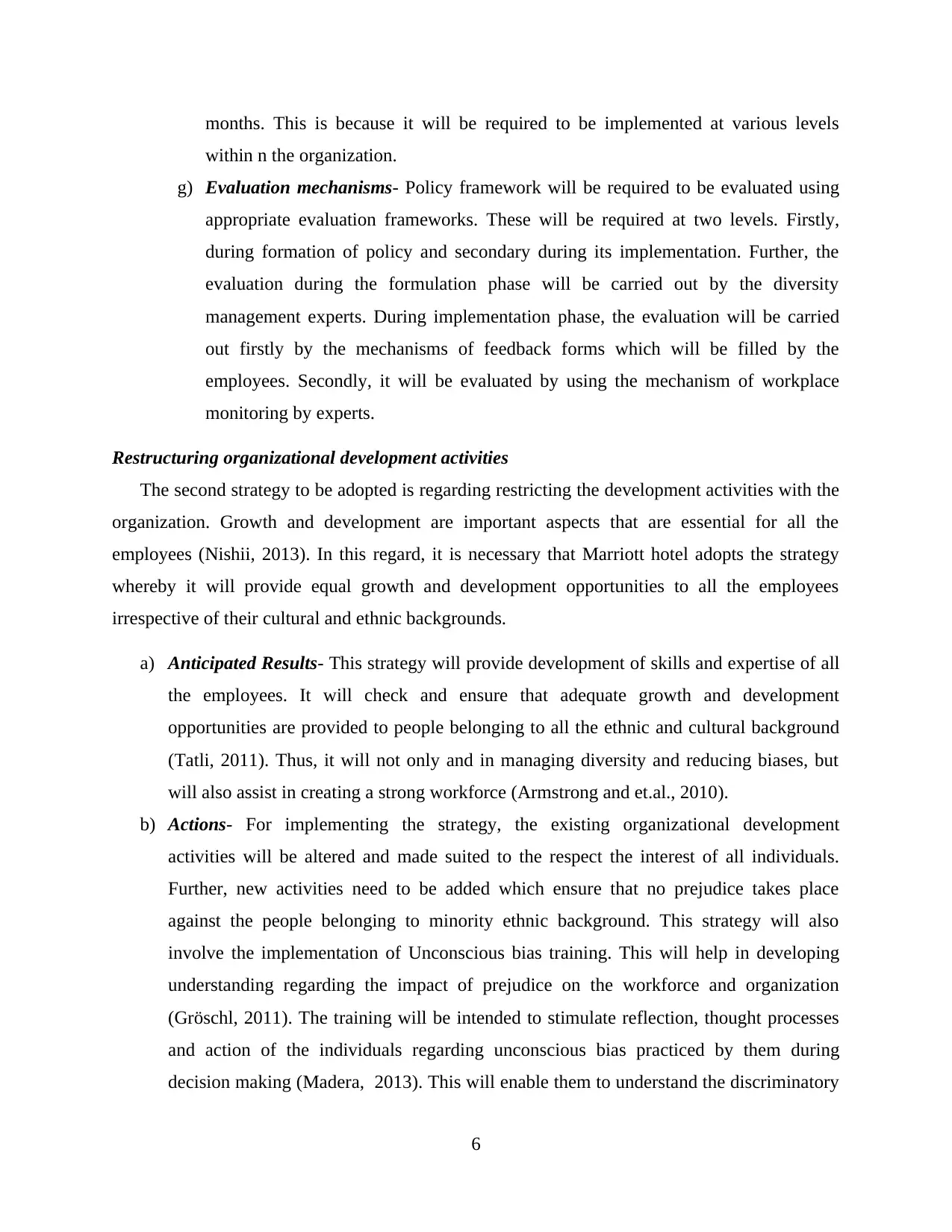
months. This is because it will be required to be implemented at various levels
within n the organization.
g) Evaluation mechanisms- Policy framework will be required to be evaluated using
appropriate evaluation frameworks. These will be required at two levels. Firstly,
during formation of policy and secondary during its implementation. Further, the
evaluation during the formulation phase will be carried out by the diversity
management experts. During implementation phase, the evaluation will be carried
out firstly by the mechanisms of feedback forms which will be filled by the
employees. Secondly, it will be evaluated by using the mechanism of workplace
monitoring by experts.
Restructuring organizational development activities
The second strategy to be adopted is regarding restricting the development activities with the
organization. Growth and development are important aspects that are essential for all the
employees (Nishii, 2013). In this regard, it is necessary that Marriott hotel adopts the strategy
whereby it will provide equal growth and development opportunities to all the employees
irrespective of their cultural and ethnic backgrounds.
a) Anticipated Results- This strategy will provide development of skills and expertise of all
the employees. It will check and ensure that adequate growth and development
opportunities are provided to people belonging to all the ethnic and cultural background
(Tatli, 2011). Thus, it will not only and in managing diversity and reducing biases, but
will also assist in creating a strong workforce (Armstrong and et.al., 2010).
b) Actions- For implementing the strategy, the existing organizational development
activities will be altered and made suited to the respect the interest of all individuals.
Further, new activities need to be added which ensure that no prejudice takes place
against the people belonging to minority ethnic background. This strategy will also
involve the implementation of Unconscious bias training. This will help in developing
understanding regarding the impact of prejudice on the workforce and organization
(Gröschl, 2011). The training will be intended to stimulate reflection, thought processes
and action of the individuals regarding unconscious bias practiced by them during
decision making (Madera, 2013). This will enable them to understand the discriminatory
6
within n the organization.
g) Evaluation mechanisms- Policy framework will be required to be evaluated using
appropriate evaluation frameworks. These will be required at two levels. Firstly,
during formation of policy and secondary during its implementation. Further, the
evaluation during the formulation phase will be carried out by the diversity
management experts. During implementation phase, the evaluation will be carried
out firstly by the mechanisms of feedback forms which will be filled by the
employees. Secondly, it will be evaluated by using the mechanism of workplace
monitoring by experts.
Restructuring organizational development activities
The second strategy to be adopted is regarding restricting the development activities with the
organization. Growth and development are important aspects that are essential for all the
employees (Nishii, 2013). In this regard, it is necessary that Marriott hotel adopts the strategy
whereby it will provide equal growth and development opportunities to all the employees
irrespective of their cultural and ethnic backgrounds.
a) Anticipated Results- This strategy will provide development of skills and expertise of all
the employees. It will check and ensure that adequate growth and development
opportunities are provided to people belonging to all the ethnic and cultural background
(Tatli, 2011). Thus, it will not only and in managing diversity and reducing biases, but
will also assist in creating a strong workforce (Armstrong and et.al., 2010).
b) Actions- For implementing the strategy, the existing organizational development
activities will be altered and made suited to the respect the interest of all individuals.
Further, new activities need to be added which ensure that no prejudice takes place
against the people belonging to minority ethnic background. This strategy will also
involve the implementation of Unconscious bias training. This will help in developing
understanding regarding the impact of prejudice on the workforce and organization
(Gröschl, 2011). The training will be intended to stimulate reflection, thought processes
and action of the individuals regarding unconscious bias practiced by them during
decision making (Madera, 2013). This will enable them to understand the discriminatory
6
⊘ This is a preview!⊘
Do you want full access?
Subscribe today to unlock all pages.

Trusted by 1+ million students worldwide
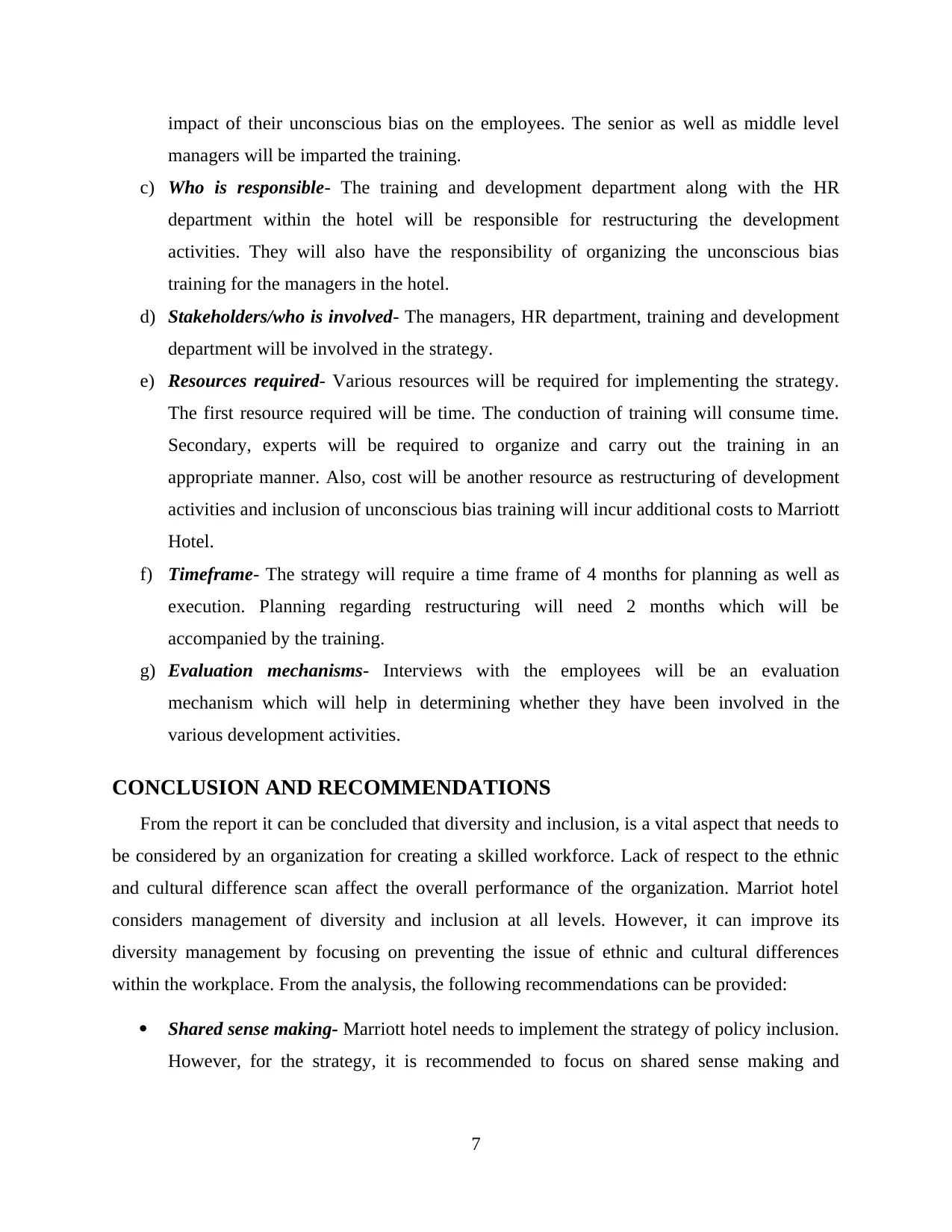
impact of their unconscious bias on the employees. The senior as well as middle level
managers will be imparted the training.
c) Who is responsible- The training and development department along with the HR
department within the hotel will be responsible for restructuring the development
activities. They will also have the responsibility of organizing the unconscious bias
training for the managers in the hotel.
d) Stakeholders/who is involved- The managers, HR department, training and development
department will be involved in the strategy.
e) Resources required- Various resources will be required for implementing the strategy.
The first resource required will be time. The conduction of training will consume time.
Secondary, experts will be required to organize and carry out the training in an
appropriate manner. Also, cost will be another resource as restructuring of development
activities and inclusion of unconscious bias training will incur additional costs to Marriott
Hotel.
f) Timeframe- The strategy will require a time frame of 4 months for planning as well as
execution. Planning regarding restructuring will need 2 months which will be
accompanied by the training.
g) Evaluation mechanisms- Interviews with the employees will be an evaluation
mechanism which will help in determining whether they have been involved in the
various development activities.
CONCLUSION AND RECOMMENDATIONS
From the report it can be concluded that diversity and inclusion, is a vital aspect that needs to
be considered by an organization for creating a skilled workforce. Lack of respect to the ethnic
and cultural difference scan affect the overall performance of the organization. Marriot hotel
considers management of diversity and inclusion at all levels. However, it can improve its
diversity management by focusing on preventing the issue of ethnic and cultural differences
within the workplace. From the analysis, the following recommendations can be provided:
Shared sense making- Marriott hotel needs to implement the strategy of policy inclusion.
However, for the strategy, it is recommended to focus on shared sense making and
7
managers will be imparted the training.
c) Who is responsible- The training and development department along with the HR
department within the hotel will be responsible for restructuring the development
activities. They will also have the responsibility of organizing the unconscious bias
training for the managers in the hotel.
d) Stakeholders/who is involved- The managers, HR department, training and development
department will be involved in the strategy.
e) Resources required- Various resources will be required for implementing the strategy.
The first resource required will be time. The conduction of training will consume time.
Secondary, experts will be required to organize and carry out the training in an
appropriate manner. Also, cost will be another resource as restructuring of development
activities and inclusion of unconscious bias training will incur additional costs to Marriott
Hotel.
f) Timeframe- The strategy will require a time frame of 4 months for planning as well as
execution. Planning regarding restructuring will need 2 months which will be
accompanied by the training.
g) Evaluation mechanisms- Interviews with the employees will be an evaluation
mechanism which will help in determining whether they have been involved in the
various development activities.
CONCLUSION AND RECOMMENDATIONS
From the report it can be concluded that diversity and inclusion, is a vital aspect that needs to
be considered by an organization for creating a skilled workforce. Lack of respect to the ethnic
and cultural difference scan affect the overall performance of the organization. Marriot hotel
considers management of diversity and inclusion at all levels. However, it can improve its
diversity management by focusing on preventing the issue of ethnic and cultural differences
within the workplace. From the analysis, the following recommendations can be provided:
Shared sense making- Marriott hotel needs to implement the strategy of policy inclusion.
However, for the strategy, it is recommended to focus on shared sense making and
7
Paraphrase This Document
Need a fresh take? Get an instant paraphrase of this document with our AI Paraphraser
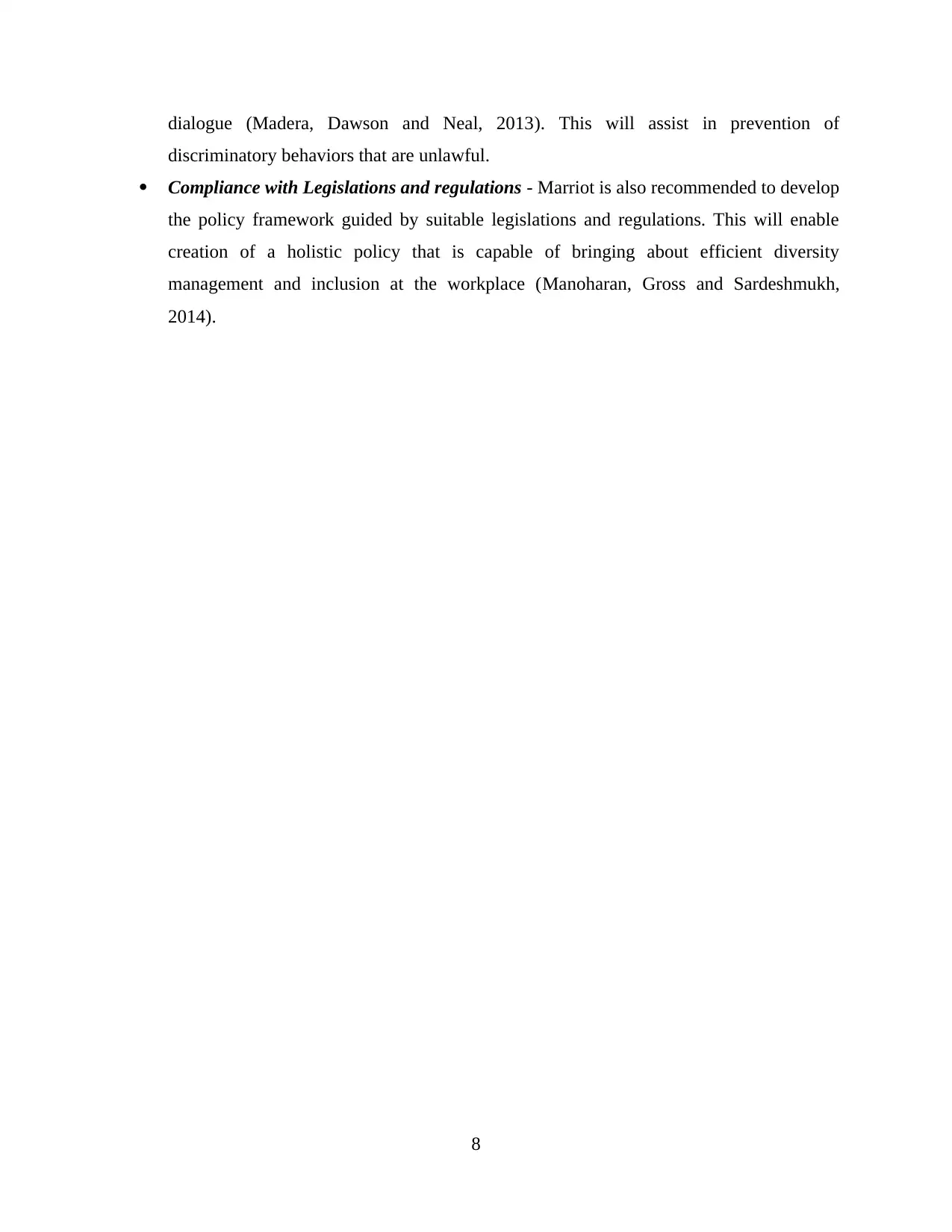
dialogue (Madera, Dawson and Neal, 2013). This will assist in prevention of
discriminatory behaviors that are unlawful.
Compliance with Legislations and regulations - Marriot is also recommended to develop
the policy framework guided by suitable legislations and regulations. This will enable
creation of a holistic policy that is capable of bringing about efficient diversity
management and inclusion at the workplace (Manoharan, Gross and Sardeshmukh,
2014).
8
discriminatory behaviors that are unlawful.
Compliance with Legislations and regulations - Marriot is also recommended to develop
the policy framework guided by suitable legislations and regulations. This will enable
creation of a holistic policy that is capable of bringing about efficient diversity
management and inclusion at the workplace (Manoharan, Gross and Sardeshmukh,
2014).
8
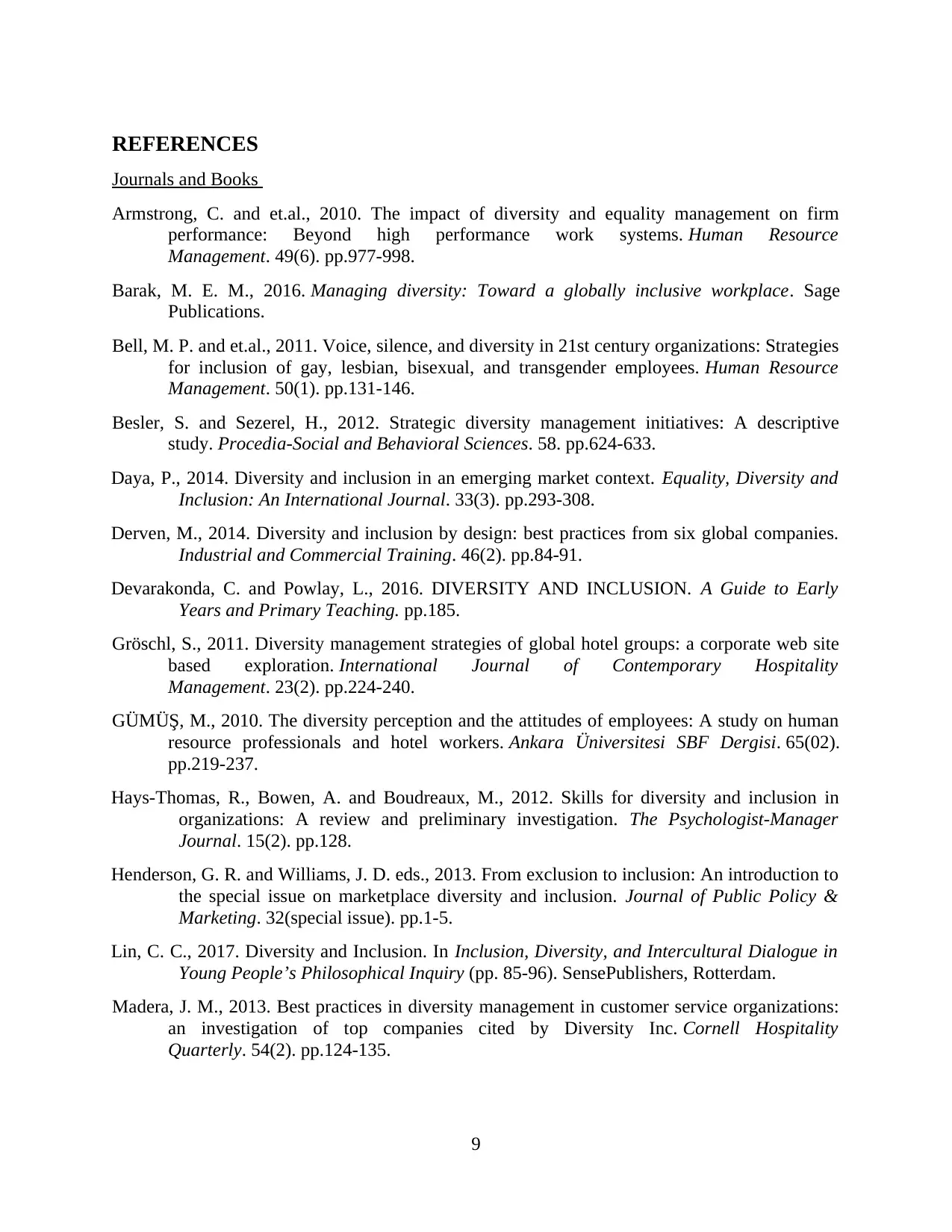
REFERENCES
Journals and Books
Armstrong, C. and et.al., 2010. The impact of diversity and equality management on firm
performance: Beyond high performance work systems. Human Resource
Management. 49(6). pp.977-998.
Barak, M. E. M., 2016. Managing diversity: Toward a globally inclusive workplace. Sage
Publications.
Bell, M. P. and et.al., 2011. Voice, silence, and diversity in 21st century organizations: Strategies
for inclusion of gay, lesbian, bisexual, and transgender employees. Human Resource
Management. 50(1). pp.131-146.
Besler, S. and Sezerel, H., 2012. Strategic diversity management initiatives: A descriptive
study. Procedia-Social and Behavioral Sciences. 58. pp.624-633.
Daya, P., 2014. Diversity and inclusion in an emerging market context. Equality, Diversity and
Inclusion: An International Journal. 33(3). pp.293-308.
Derven, M., 2014. Diversity and inclusion by design: best practices from six global companies.
Industrial and Commercial Training. 46(2). pp.84-91.
Devarakonda, C. and Powlay, L., 2016. DIVERSITY AND INCLUSION. A Guide to Early
Years and Primary Teaching. pp.185.
Gröschl, S., 2011. Diversity management strategies of global hotel groups: a corporate web site
based exploration. International Journal of Contemporary Hospitality
Management. 23(2). pp.224-240.
GÜMÜŞ, M., 2010. The diversity perception and the attitudes of employees: A study on human
resource professionals and hotel workers. Ankara Üniversitesi SBF Dergisi. 65(02).
pp.219-237.
Hays-Thomas, R., Bowen, A. and Boudreaux, M., 2012. Skills for diversity and inclusion in
organizations: A review and preliminary investigation. The Psychologist-Manager
Journal. 15(2). pp.128.
Henderson, G. R. and Williams, J. D. eds., 2013. From exclusion to inclusion: An introduction to
the special issue on marketplace diversity and inclusion. Journal of Public Policy &
Marketing. 32(special issue). pp.1-5.
Lin, C. C., 2017. Diversity and Inclusion. In Inclusion, Diversity, and Intercultural Dialogue in
Young People’s Philosophical Inquiry (pp. 85-96). SensePublishers, Rotterdam.
Madera, J. M., 2013. Best practices in diversity management in customer service organizations:
an investigation of top companies cited by Diversity Inc. Cornell Hospitality
Quarterly. 54(2). pp.124-135.
9
Journals and Books
Armstrong, C. and et.al., 2010. The impact of diversity and equality management on firm
performance: Beyond high performance work systems. Human Resource
Management. 49(6). pp.977-998.
Barak, M. E. M., 2016. Managing diversity: Toward a globally inclusive workplace. Sage
Publications.
Bell, M. P. and et.al., 2011. Voice, silence, and diversity in 21st century organizations: Strategies
for inclusion of gay, lesbian, bisexual, and transgender employees. Human Resource
Management. 50(1). pp.131-146.
Besler, S. and Sezerel, H., 2012. Strategic diversity management initiatives: A descriptive
study. Procedia-Social and Behavioral Sciences. 58. pp.624-633.
Daya, P., 2014. Diversity and inclusion in an emerging market context. Equality, Diversity and
Inclusion: An International Journal. 33(3). pp.293-308.
Derven, M., 2014. Diversity and inclusion by design: best practices from six global companies.
Industrial and Commercial Training. 46(2). pp.84-91.
Devarakonda, C. and Powlay, L., 2016. DIVERSITY AND INCLUSION. A Guide to Early
Years and Primary Teaching. pp.185.
Gröschl, S., 2011. Diversity management strategies of global hotel groups: a corporate web site
based exploration. International Journal of Contemporary Hospitality
Management. 23(2). pp.224-240.
GÜMÜŞ, M., 2010. The diversity perception and the attitudes of employees: A study on human
resource professionals and hotel workers. Ankara Üniversitesi SBF Dergisi. 65(02).
pp.219-237.
Hays-Thomas, R., Bowen, A. and Boudreaux, M., 2012. Skills for diversity and inclusion in
organizations: A review and preliminary investigation. The Psychologist-Manager
Journal. 15(2). pp.128.
Henderson, G. R. and Williams, J. D. eds., 2013. From exclusion to inclusion: An introduction to
the special issue on marketplace diversity and inclusion. Journal of Public Policy &
Marketing. 32(special issue). pp.1-5.
Lin, C. C., 2017. Diversity and Inclusion. In Inclusion, Diversity, and Intercultural Dialogue in
Young People’s Philosophical Inquiry (pp. 85-96). SensePublishers, Rotterdam.
Madera, J. M., 2013. Best practices in diversity management in customer service organizations:
an investigation of top companies cited by Diversity Inc. Cornell Hospitality
Quarterly. 54(2). pp.124-135.
9
⊘ This is a preview!⊘
Do you want full access?
Subscribe today to unlock all pages.

Trusted by 1+ million students worldwide
1 out of 13
Related Documents
Your All-in-One AI-Powered Toolkit for Academic Success.
+13062052269
info@desklib.com
Available 24*7 on WhatsApp / Email
![[object Object]](/_next/static/media/star-bottom.7253800d.svg)
Unlock your academic potential
Copyright © 2020–2025 A2Z Services. All Rights Reserved. Developed and managed by ZUCOL.





